Physical Address
304 North Cardinal St.
Dorchester Center, MA 02124
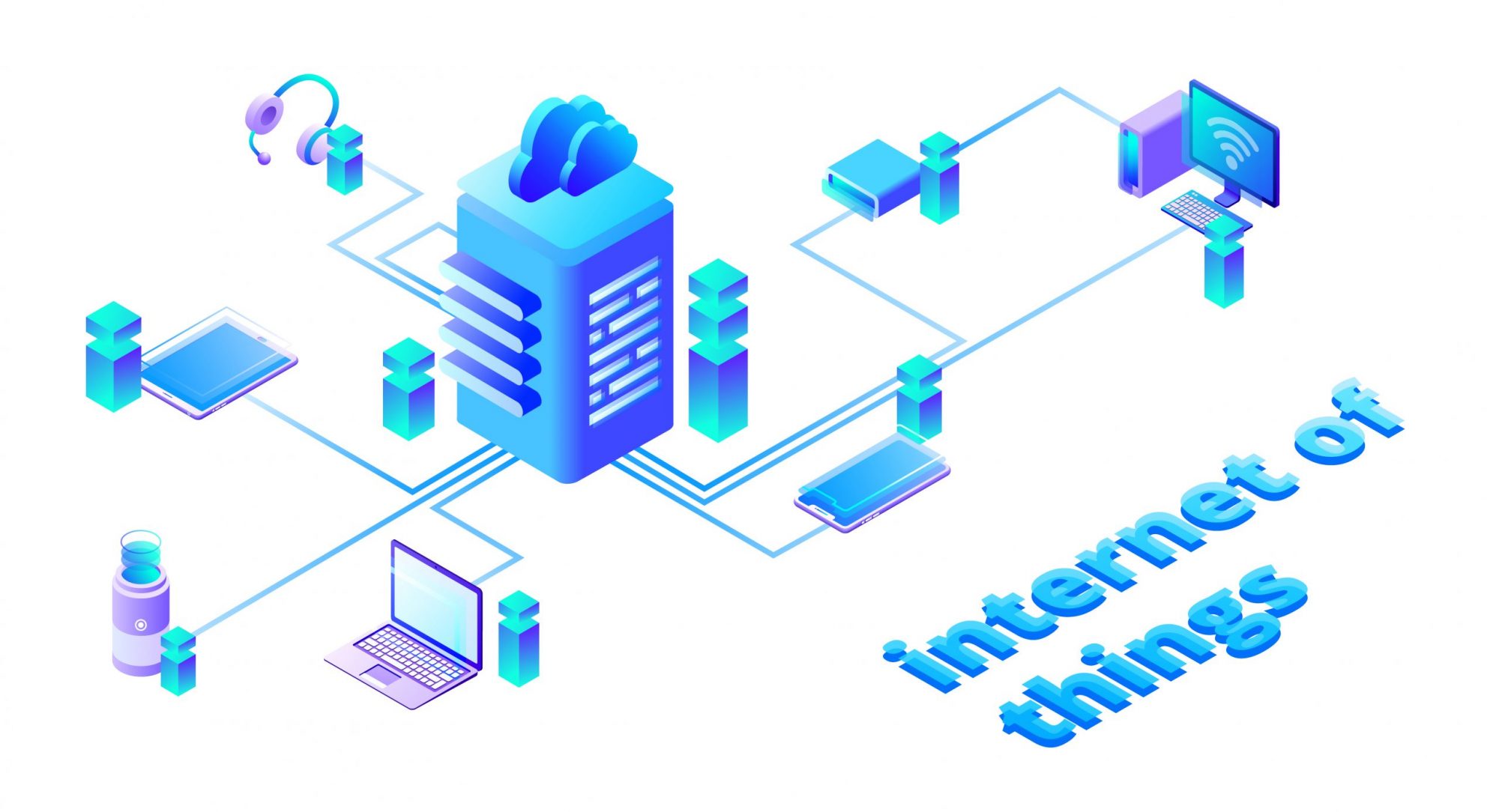
RadiRadio Frequency Identification (RFID) technology uses radio waves to identify person or objects. There is a device that reads information contained in a wireless device or “tag” from a distance without making any physical contact or requiring a line of sight
There are three components that makes the RFID system work: Switching antenna, signal transceiver and signal transponder (tag). The part of the tag that encodes the data is called the RFID inlay.
RFID is a wireless technology that works with two main parts: tags and readers. The reader is a
device that has one or more antennas that send and receive electromagnetic signals from RFID tags. These tags, which built in a serial numbers or unique identifiers or chips, use radio waves or electromagnetic signals to send their data to nearby readers. They contain RFID chips, also known as integrated circuits (IC), which communicate data to the reader.
RFID are a group of technologies called automatic identification and data collection (AIDC). AIDC tools uses to identify items, collect datas about them, and send that datas to the computer system, even with no human interaction.
For example the retailers who needs to track stock accuracy, the RFID system that integrates with your inventory can increase efficiencies significantly. You can use it to improve inventory accuracy and visibility, that will create a better shopping experience for today’s omnichannel shoppers.
The system is composed of various RFID devices, and when configured correctly, it can achieve 100% reading rates. The following are the different devices and components of an RFID system:
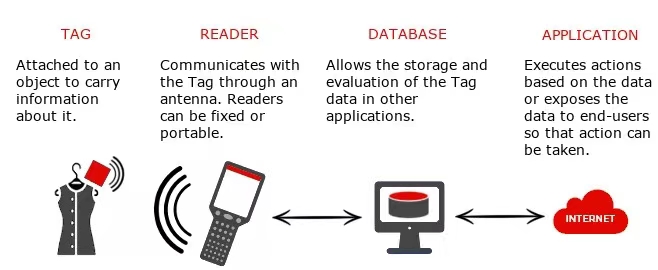
The first one is the RFID reader, These devices are responsible for powering the RFID tags through the antennas. While doing this, they capture the tags’ data, decode it, and transmit it to the corresponding software for interpretation.
And then is the RFID antennas, these are used to read RFID tags in warehouses, production lines, stores, medical centers, sporting events, etc. The antenna creates a three-dimensional action field around it called a beam (pattern), radiation pattern, or bulb
And the important part is the tags, the tags with chips inside is a type of tracking system that uses radio frequency to search, identify, track, and communicate with the readers. Essentially, RFID tags are smart labels that can store a range of information from serial numbers, to a short description, and even pages of data
The last but not least one is the RFID software, the software platform designed to capture data dynamically and intelligently in any business structure and sector. It controls the physical movements of goods, containers, people, returnable assets, etc. in real-time without human intervention.
Depending on the frequency band they operate at we find different systems: low frequency (LF), high frequency (HF / NFC) and utra-high frequency (UHF).
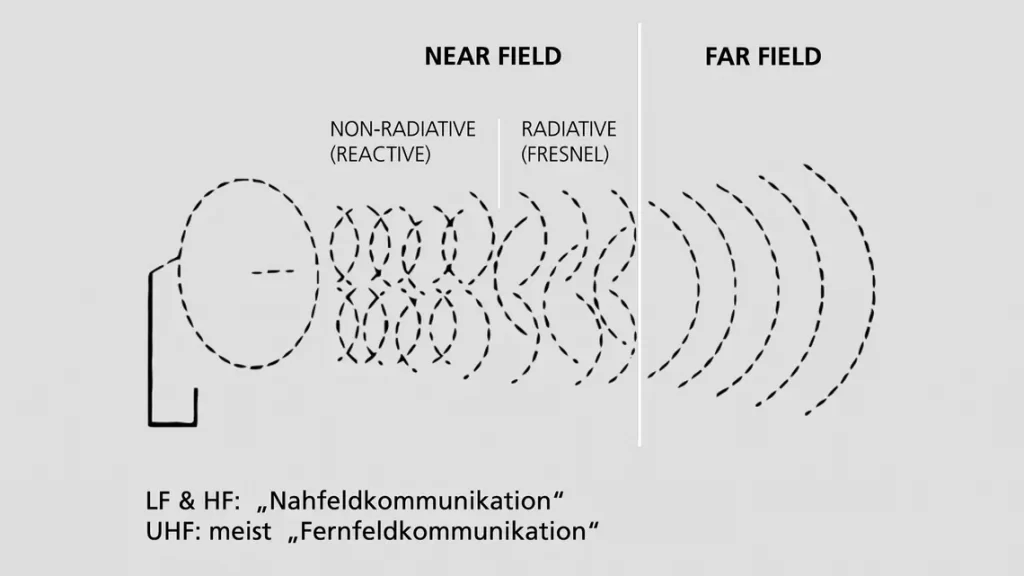
The LF band covers frequencies between 30KHz to 300Khz. Typical LF RFID systems work with 125 KHz or 134 Khz. This frequency provides a short reading range, about 10 cm, and the reading speed is slow. It is very resistant to external interference.
Typical applications of LF are access control and animal control.
Standard norms for traceability systems for animals are defined in ISO 14223, and ISO / IEC 18000-2. The LF spectrum is not considered a frequency for global applications due to the different frequencies and reading powers that work around the world.
The ranges of the HF frequencies go from 3 to 30 MHz. Most RFID HF systems work with 13.56 MHz, with reading ranges between 10cm and 1m. Interferences moderately affect HF systems. HF systems are commonly used for ticketing, payments and data transfer applications.
There are a few standards for HF RFID: ISO 15693 is the standard for object traceability; ECMA-340 and ISO / IEC 18092 are for the NFC (Near Field communication), a technology with short reading ratio used for change of data between devices. The MIFARE standards are ISO / IEC 14443 A and ISO / IEC 14443, which is used in smart cards, and JIS X 6319-4 for FeliCa which is normally used in cards with payment systems.
UHF systems cover frequency ranges from 300Mhz to 3Ghz. RAIN RFID systems comply with the standard UHF Gen2 standard that uses frequencies 860 to 960 MHz. There are differences in variation between regions, most of them operate between 900 and 915 Mhz.
UHF RFID reading systems can reach more than 15 meters, have very fast data transmission and are very sensitive to interference. But today, most manufacturers of RFID products such as Dipole, have found a way to design tags, antennas and readers that give a high performance in complex environments. UHF tags are easier and cheaper to manufacture compared to LF and HF.
UHF frequency is regulated by a global standard called EPC Global Gen2 (ISO 1800-63) UHF standard. Impinj and Smartrac, main partners of Dipole RFID, are two of the great propellers of RFID worldwide developing universal solutions so that RFID can be adapted in most sectors.
RFID technology can be used in a wide variety of processes and sectors. More and more industries are adopting this identification system. Here are some examples of RFID technology and its potential applications:
This is one of the most common uses of this technology. With an RFID tag, real-time and rapid control of products entering and leaving a warehouse or people participating in an event can be achieved. To do this, RFID portals can be placed at access points, capable of identifying the number of tags passing through them and their carrier.
Companies can obtain a wealth of information for the management and control of activities. Examples include, but are not limited to, goods entries and exits, order distribution (the entire process), worker identification and access, event entry supervision, door locking in hotels, and many more.
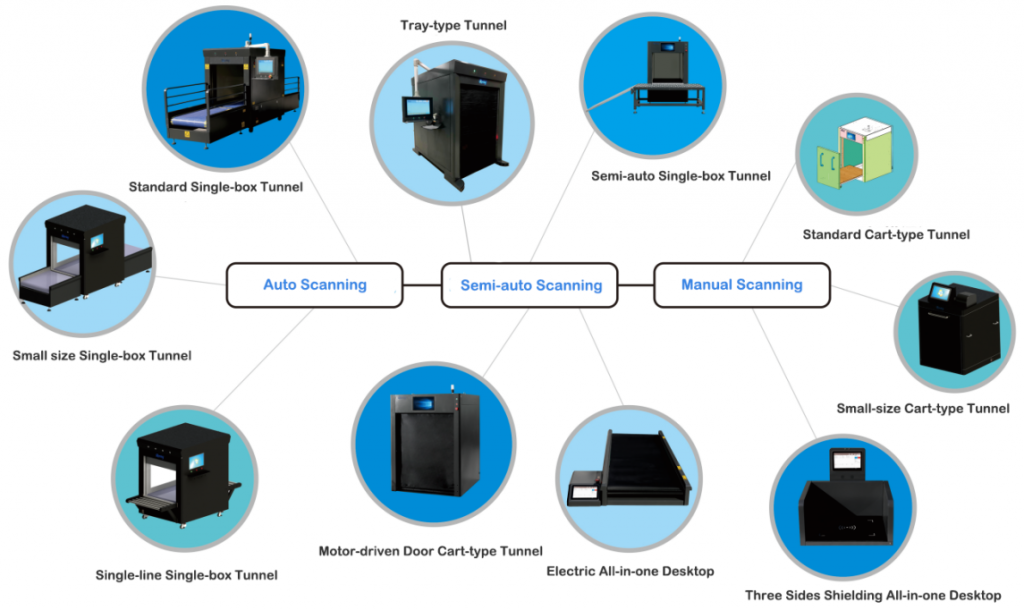
To be competitive today, it is essential to improve production times, reduce direct labor in non-value-added processes, and increase overall company productivity. The industrial sector has found RFID technology to be a great ally, offering advantages such as data capture in procedures where it is impossible or costly to do manually. It has streamlined and optimized all processes within industrial activity, with many sectors incorporating it into their systems.
One of the fundamental applications is improving the overall supply chain by automating, simplifying, or even eliminating identification and data capture tasks at various points in the chain, ensuring traceability. RFID tags are placed on all products to be tracked, providing information about them at each stage of the process. This simplification leads to benefits such as increased productivity and efficiency and reduced operational costs.
Logistics processes have experienced positive change due to RFID systems: the interaction between manufacturing, distribution centers, and stores is much more agile and effective. Goods can be identified massively and reliably, avoiding manual information verification. Warehouse management is improved, allowing automated loading and unloading of goods. Order preparation, packing, and collection times are reduced, and errors are easily detected.By applying radiofrequency to logistics, businesses gain a global view, ensuring good service and increasing productivity by 20-30% more than using barcodes.
Retail is one of the sectors that has benefited the most. Adhesive RFID tags placed on products allow the exact location of each item to be known at all times, as well as storing relevant information about them. This greatly simplifies inventory management, preventing stockouts. These tags can also be used as anti-theft systems, only deactivated when passing through the checkout; a detection gate will sound an alarm if someone tries to take a product without paying.
In addition, this technology can offer customers a new shopping experience through interactive screens and fitting rooms, which allow for product identification and information, purchase recommendations, or requests for different sizes and colors, among other options.
Overall, RFID is a useful tool for improving customer satisfaction and increasing sales volume. Fashion, jewelry, and cosmetics are some of the sectors where this technology has become indispensable.
Today, RFID technology is the best system for tagging clothing and other retail products in an easy, fast, and effective way.
Hospitals also collect large amounts of data daily, essential for the proper functioning of all treatments performed there (patient admissions and discharges, medical supplies, medications, access data to restricted areas for hospital staff, etc.). Collecting all this data requires a system capable of storing and updating it immediately, simply, and securely. Thus, the tools of RFID technology can be helpful.
RFID technology offers numerous advantages in ensuring food traceability at any stage of the production process
It allows product entries from the field with alerts for ripening time or other associated processes; temperature control in the cold chain; movement registration between drying chambers/curing zones; and even controlling turnovers in cheese curing processes and similar products. We can also create alerts to prevent obsolete or expired stock.
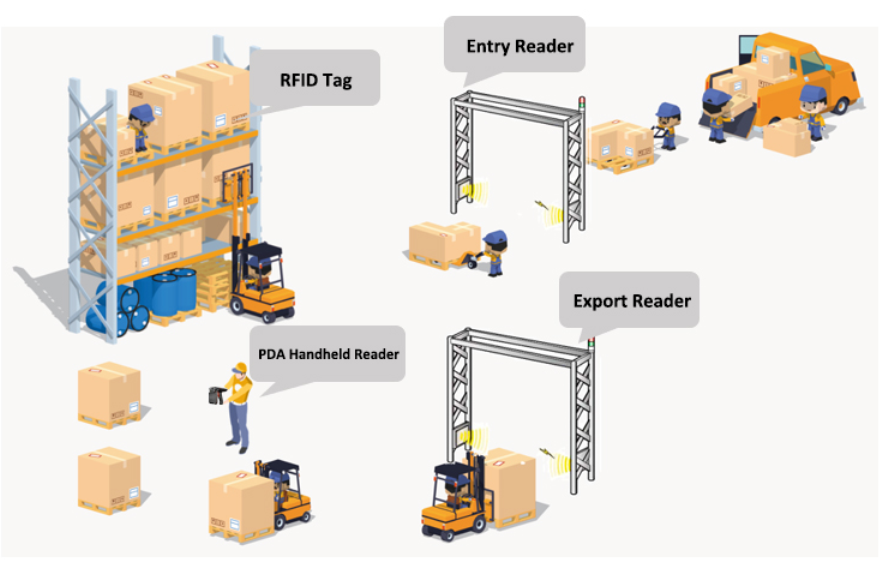
RFID tags provide books and/or documents with a unique identification number, allowing for more accurate and effective tracking since the system can read the identification of multiple units simultaneously and avoid manual identification. Additionally, this technology is used for the authentication of official documents, preventing forgery. Implementing RFID technology in a library enables real-time registration of book loans and returns and control of due dates. Users can access the information they need at any time. With this system, a library user could check from home if a book or CD is available at the library or not.
We can record asset movements in real-time, enabling control and management on-site or from a remote location. By identifying assets with appropriate tags, we can easily locate them even if they have been moved and placed where they do not belong. We can even record changes in environmental conditions for critical products.
These systems help prevent asset loss or misplacement while simplifying management and reducing operational costs.
With RFID technology, we can manage the inventory process in real-time, automatically: we can assign a unique identifier to each stored product, avoiding duplicates and discrepancies; we can easily obtain relevant information about stored products and their location; and we can maintain a more accurate and constantly updated stock.This way, we can save time and reduce costs while increasing productivity, avoiding errors, and preventing unnecessary expenses.